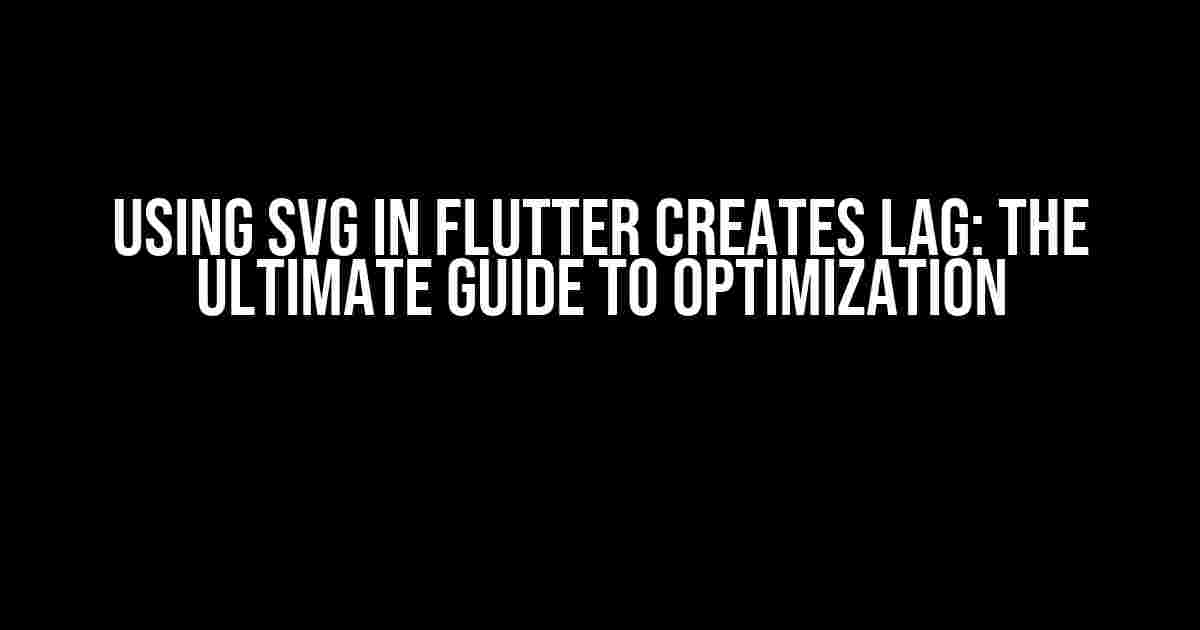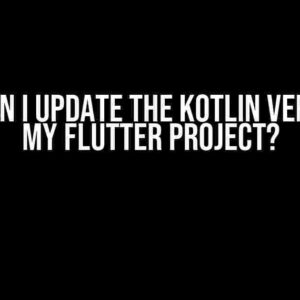Are you tired of dealing with sluggish performance in your Flutter app every time you try to use SVGs? You’re not alone! Many developers face this issue, and it’s not because SVGs are inherently slow. The good news is that with the right techniques and optimizations, you can enjoy the benefits of using SVGs in Flutter without sacrificing performance.
The Problem with SVGs in Flutter
Before we dive into the solutions, let’s understand why SVGs can cause lag in Flutter. There are a few reasons for this:
- Rasterization**: SVGs need to be rasterized (converted into pixels) before they can be displayed on the screen. This process can be computationally expensive, especially for complex SVGs.
- Lack of optimization**: Without proper optimization, Flutter’s SVG rendering engine can become overwhelmed, leading to lag and performance issues.
- Memory usage**: SVGs can consume a significant amount of memory, especially when dealing with large or complex graphics. This can lead to performance degradation and even crashes.
Optimizing SVGs for Flutter
Now that we understand the root causes of the problem, let’s explore some techniques to optimize SVGs for Flutter:
1. Simplify Your SVGs
Complex SVGs can lead to performance issues, so it’s essential to simplify them before using them in your Flutter app. Here are a few ways to do this:
- Remove unnecessary elements**: Take a closer look at your SVG and remove any elements that aren’t necessary for the design. This can include unnecessary paths, groups, or attributes.
- Use simpler shapes**: Instead of using complex shapes, try to break them down into simpler ones. For example, use a rectangle instead of a complex polygon.
- Reduce the number of nodes**: Fewer nodes mean less computational overhead. Try to reduce the number of nodes in your SVG by merging or removing them.
<svg>
<circle cx="50" cy="50" r="40" fill="blue">
<animateTransform attributeName="transform" type="rotate" from="0 50 50" to="360 50 50" dur="10s" repeatCount="indefinite"></animateTransform>
</circle>
</svg>
<svg>
<circle cx="50" cy="50" r="40" fill="blue"></circle>
</svg>
In the example above, we removed the unnecessary `
2. Use the Right Tools
Using the right tools can make a huge difference in optimizing your SVGs for Flutter. Here are a few tools you can use:
- SVGO**: A popular tool for optimizing SVGs. You can use it to simplify your SVGs, remove unnecessary elements, and reduce their size.
- SvgCleaner**: A tool specifically designed for cleaning and optimizing SVGs for mobile apps. It can help you remove unnecessary elements, reduce the number of nodes, and optimize the SVG for mobile devices.
// Install SVGO using npm npm install svgo // Optimize an SVG using SVGO svgo -i input.svg -o output.svg
3. Use Caching
Caching can significantly improve performance by reducing the number of times the SVG needs to be rasterized. Here’s how you can implement caching in Flutter:
import 'package:flutter/material.dart';
import 'package:flutter_svg/flutter_svg.dart';
class CachedSvg extends StatefulWidget {
@override
_CachedSvgState createState() => _CachedSvgState();
}
class _CachedSvgState extends State<CachedSvg> {
SvgPicture _cachedSvg;
@override
void didChangeDependencies() {
super.didChangeDependencies();
_loadSvg();
}
Future<void> _loadSvg() async {
final svgString = await rootBundle.loadString('assets/svg/optimized_svg.svg');
final svgPicture = SvgPicture.string(svgString);
setState(() {
_cachedSvg = svgPicture;
});
}
@override
Widget build(BuildContext context) {
return _cachedSvg ?? Container();
}
}
In the example above, we load the SVG string using `rootBundle.loadString` and store it in a cache using a `setState` method. This way, the SVG is only rasterized once, and the cached version is used for subsequent builds.
4. Use a Fast SVG Renderer
Flutter’s default SVG renderer can be slow, especially for complex SVGs. Here are a few fast SVG renderers you can use:
- Flutter SVG**: A high-performance SVG renderer for Flutter. It’s designed to be fast and optimized for mobile devices.
- svg2flutter**: A library that converts SVGs into Flutter widgets. It’s fast, lightweight, and optimized for mobile devices.
// Install Flutter SVG using pub
flutter pub add flutter_svg
// Import Flutter SVG
import 'package:flutter_svg/flutter_svg.dart';
// Use Flutter SVG to render an SVG
SvgPicture.asset('assets/svg/optimized_svg.svg')
Common Pitfalls to Avoid
When working with SVGs in Flutter, there are a few common pitfalls to avoid:
- Don’t use too many SVGs**: Using too many SVGs can lead to performance issues, especially if they’re complex or large. Try to limit the number of SVGs you use in your app.
- Avoid large SVGs**: Large SVGs can be slow to render and can cause performance issues. Try to optimize your SVGs to reduce their size and complexity.
- Don’t forget to cache**: Caching is essential for optimizing SVGs in Flutter. Make sure to cache your SVGs to reduce the number of times they need to be rasterized.
- Test on multiple devices**: SVG performance can vary across different devices and screen sizes. Make sure to test your app on multiple devices to ensure optimal performance.
Conclusion
Using SVGs in Flutter can be a great way to add vector graphics to your app, but it requires careful optimization to avoid performance issues. By following the techniques outlined in this article, you can ensure that your SVGs are optimized for Flutter and provide a smooth user experience for your users.
| Optimization Technique | Description |
|---|---|
| Simplify SVGs | Remove unnecessary elements, use simpler shapes, and reduce the number of nodes. |
| Use the Right Tools | Use tools like SVGO and SvgCleaner to optimize and simplify your SVGs. |
| Use Caching | Cache your SVGs to reduce the number of times they need to be rasterized. |
| Use a Fast SVG Renderer | Use a fast SVG renderer like Flutter SVG or svg2flutter to improve performance. |
By following these optimization techniques, you can ensure that your SVGs are optimized for Flutter and provide a fast and smooth user experience for your users.
Frequently Asked Question
Are you tired of dealing with laggy performance in your Flutter app when using SVGs? Worry no more! We’ve got the answers to your burning questions.
Why does using SVG in Flutter create lag?
SVG rendering can be computationally expensive, especially when dealing with complex vector graphics. Flutter’s default SVG renderer, `SvgPicture`, uses the browser’s SVG rendering engine, which can lead to performance issues. Additionally, Flutter’s widget tree and layout system can also contribute to lag when rendering SVGs.
How can I optimize SVGs for better performance in Flutter?
Optimize your SVGs by simplifying paths, reducing the number of nodes, and using CSS styles instead of inline attributes. You can also use tools like SVGO or SVGOMG to compress and optimize your SVG files. Additionally, consider using a more efficient SVG rendering library like `flutter_svg`.
What are some alternative ways to display vector graphics in Flutter besides SVG?
You can use other vector graphics formats like PNG, WebP, or even raster images. However, if you need to maintain the scalability and flexibility of vector graphics, consider using Flutter’s built-in `CustomPainter` or `Path` classes to render your graphics programmatically.
Can I use a caching mechanism to improve SVG performance in Flutter?
Yes, caching can help improve performance by reducing the number of SVG rendering operations. You can use packages like `flutter_cache_manager` or ` cache_image` to cache your SVGs. Additionally, consider using a package like `flutter_svg_cache` which provides a caching mechanism specifically designed for SVGs.
Are there any Flutter packages that can help me with SVG rendering and performance?
Yes, there are several packages available that can help with SVG rendering and performance. Some popular ones include `flutter_svg`, `svg_parse`, and `flutter_vector_icons`. These packages provide optimized SVG rendering, caching, and other features to help improve performance.


